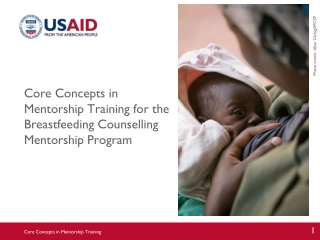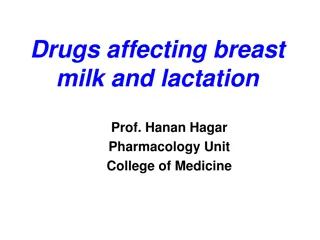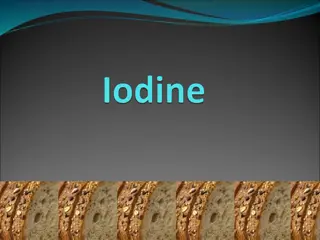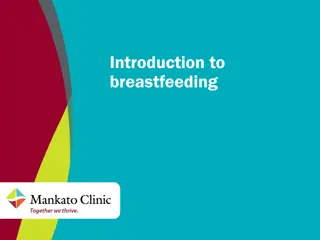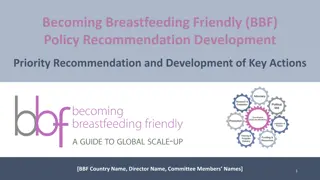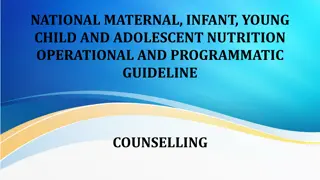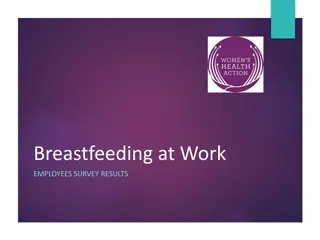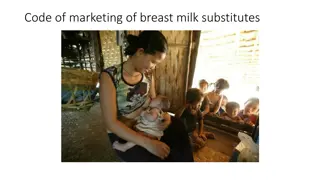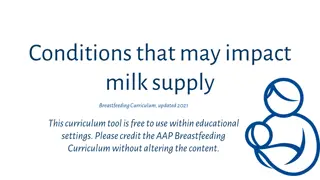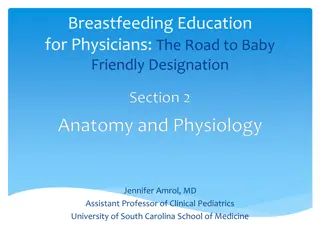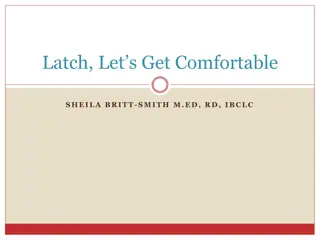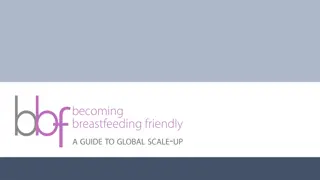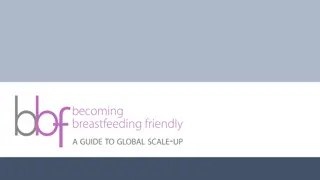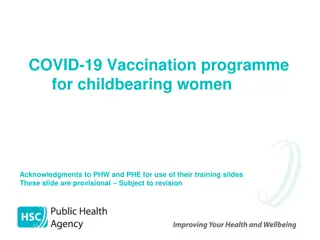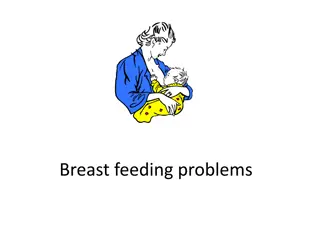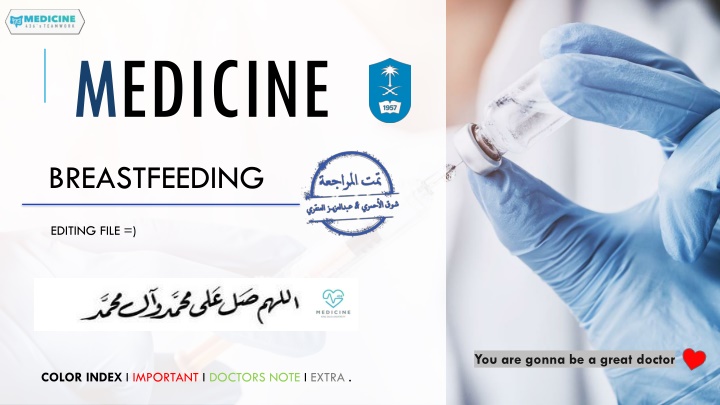
Breastfeeding Benefits and Recommendations
Learn about the importance of breastfeeding for child health and survival, including exclusive breastfeeding up to 6 months, introducing complementary foods, and understanding the properties of breast milk. Empower parents with knowledge to make informed choices for their child's well-being.
Download Presentation

Please find below an Image/Link to download the presentation.
The content on the website is provided AS IS for your information and personal use only. It may not be sold, licensed, or shared on other websites without obtaining consent from the author. If you encounter any issues during the download, it is possible that the publisher has removed the file from their server.
You are allowed to download the files provided on this website for personal or commercial use, subject to the condition that they are used lawfully. All files are the property of their respective owners.
The content on the website is provided AS IS for your information and personal use only. It may not be sold, licensed, or shared on other websites without obtaining consent from the author.
E N D
Presentation Transcript
MEDICINE BREASTFEEDING EDITING FILE =) EDITING FILE =) You are gonna be a great doctor COLOR INDEX I IMPORTANT I DOCTORS NOTE I EXTRA .
OBJECTIVES To increase awareness about the benefits of breastfeeding. To know about the properties of breastfeeding. To educate about the basics of breastfeeding and empower parents to make an informed choice. To educate about the harms associated with formula feeding. To know about the contraindication of breastfeeding
BREASTFEEDING AND RECOMMENDATIONS Breastfeeding is one of the most effective ways to ensure child health and survival . If every child was breastfed within an hour of birth, given only breast milk for their first six months of life, and continued breastfeeding up to the age of two years, about 800 000 child lives would be saved every year . Globally, less than 40% of infants under six months of age are exclusively(1) breastfed Around 32% of children less than 5 years of age in developing countries are stunted(2) and 10% are wasted. It is estimated that sub-optimal breastfeeding, especially non-exclusive breastfeeding in the first 6 months of life, results in 1.4 million deaths and 10% of the disease burden in children younger than 5 years. (1) exclusively means only (2) (2) short stature
BREASTFEEDING AND RECOMMENDATIONS CONT Exclusive breastfeeding until 6 months of age(1) Introduce complimentary foods with continued breastfeeding up to 2 years. In addition: breastfeeding should begin within one hour of birth. breastfeeding should be "on demand", as often as the child wants day and night; and bottles or pacifiers should be avoided. breastfeeding should not be decreased when starting on solids. Signs of baby that He/She is hungry: A baby can show that he or she is hungry by: Waking up from sleep. Moving the head around . ( as if he or she is looking for the breast ) Sucking on his or her hands, lips, or tongue. Baby is getting enough milk if He/She : ( after 4th or 5th day of birth ) 4 or more bowel movements a day ( after 4th day of birth ) Gaining weight . at least 6 wet diapers a day * After 6 months we don t call it exclusive any more (1) No intervention with any thing
PROPERTIES OF BREAST MILK AND ITS COMPOSITIONS Important for brain and retinal development Long- chain omega-3 Fatty Acids Biologic specificity Higher IQs VITAMINS AND MENIRALS BREAST MILK COMPOSITION MILK VOLUME Protein: The concentration of protein in breast milk (0.9 g per 100 ml) is lower than in animal milks. Fat: (3.5 g per 100ml) provides up to 50% of caloric needs, cholesterol levels constant, lipolytic enzymes aid in fat digestion) Carbohydrates: (lactose = milk sugar) predominantly in human milk (7 g per 100 ml) provides up to 40% caloric needs, essential for development of CNS, enhances calcium & iron absorption) Breast milk normally contains sufficient vitamins for an infant, unless the mother herself is deficient. The exception is vitamin D(2). The infant needs exposure to sunlight to generate endogenous vitamin D or, if this is not possible, a supplement. The minerals iron and zinc are present in relatively low concentration, but their bioavailability and absorption is high. Healthy exclusively breastfeeding women produce approximately 750 to 800 mL per day of milk when lactation is fully established. However, milk volume varies among individuals and can range from 450 to 1200 mL(1) per day. Milk volume is low on the first two days postpartum, increases markedly on days three and four, then gradually increases to levels seen in full lactation. (1) Considered as good amount. (2) Total of 400 IU , 4
BREAST MILK COMPOSITIONS CONT ANTIMICROBIAL ACTIVITY OF BREAST MILK HORMONAL CONTROL OF MILK PRODUCTION IMMUNOLOGIC SPECIFICITY Breast milk contains many factors that help to protect an infant against infection including: Colostrum = Baby s first vaccination Is the special milk that is secreted in the first 2 3 days after delivery. It is produced in small amounts, about 40 50 ml on the first day, but is all that an infant normally needs at this time. Colostrum is rich in white cells and antibodies, especially IgA, and it contains a larger percentage of protein, minerals and fat-soluble vitamins (A, E and K)(1) than later milk There are two hormones that directly affect breastfeeding: prolactin and oxytocin. The prolactin level is highest about 30 minutes after the beginning of the feed, so its most important effect is to make milk for the next Feed. More prolactin is produced at night, so breastfeeding at night is especially helpful for keeping up the milk supply.(2) 1- Immunoglobulin, principally (IgA), which coats the intestinal mucosa and prevents bacteria from entering the cells. 2- White blood cells which can kill micro- organisms. 3- Whey proteins (lysozyme and lactoferrin) which can kill bacteria, viruses and fungi. 4- Oligosaccharides which prevent bacteria from attaching to mucosal surfaces 5- Carbohydrates (Bifidus factor = growth factor present only in human milk required for establishing an acidic environment in the gut to inhibit growth of bacteria, fungi and parasite) (1) (2) ( 3 ) - ( 2 ) - 1 ) - ( :
BENEFITS OF BREAST MILK Just read it For Mother : Saves resources, Less waste, No refrigeration, No manufacturing, No bottles or cans, No trucking, No handling Ecological Psychological (Attachment, bonding, security). Decreased postpartum bleeding, depression, type 2 DM. More rapid uterine involution due to increased of oxytocin. Decreased menstrual blood loss. Method of birth control (98% protection in the first six months after birth). Earlier return to pre-pregnancy weight Decreased risk of breast cancer. Decreased risk of ovarian cancer. Decreased risk of hip fractures and Osteoporosis in the postmenopausal period. smarter, healthier, less cost to healthcare system and stronger families Less trips to doctors, hospitals, Less prescriptions, Less stress, Less illness, More bonding, Inexpensive Society Families Better dental health, increased visual acuity, Decreased duration and intensity of illnesses, Less allergies, Better health & less risk of illnesses baby
BENEFITS OF BREAST MILK CONT Breast feeding And UTI(1) The risk of UTI was 2-3 times higher in non-breastfed children when compared with exclusively breastfed children The protective effect of breastfeeding was dependent on the duration of breastfeeding as well as the gender of the child or infant. A longer duration of breastfeeding was associated with a risk of infection after weaning and the effect was stronger in girls. When can I start breastfeeding? (2) Most women can start breastfeeding within a few hours after giving birth. For the first few days, most women make only a small amount of yellowish milk called colostrum. Colostrum has all of the nutrition for newborn needs. Most women start making more milk after 2 or 3 days. Initiation of Breast Feeding: Should be started within 30-60 min. of delivery. Baby should be fed on demand. With-in 4-6 weeks baby goes into routine. Breast Feeding should be given for 5-15 minutes. Both breast should be offered. Timing of breastfeeding initiation: Early breastfeeding: if initiated to baby within the first one hour of birth. Delayed breastfeeding: if the time of the first breastfeeding initiation is more than one hour after birth). Signs for adequate breastfeeding A satisfactory weight gain of baby. Baby looks active and well. Passes frequent but normal stools. Urinates a number of times/ daily without any sinister signs. UTI 3 ( 1 ) ( 2 )
STEPS TO SUCCESSFUL BREASTFEEDING JUST READ IT WHO/UNICEF Ten Steps to Successful Breastfeeding 1 Have a written breastfeeding policy communicated to all health care staff. 2 Train all health care staff to implement this policy 6 Give newborn infants no food or drink other than breast milk, unless medically indicated 7 Allow mothers and infants to remain together 24 hour a day 8 Encourage breast feeding on demand 3 Inform all pregnant women about benefits of breastfeeding 4 Initiate the breastfeeding within the first hour 9 Give no artificial nipples or pacifiers to breastfeeding infants 10 Foster the establishment of breastfeeding support groups and refer mothers to them on discharge from hospital 5 Show mothers how to breastfeed and how to maintain lactation
WHY SOME MOTHERS CHOOSE FORMULA INSTEAD? o Distressed by physical discomfort of early breastfeeding problems. o Moms given very little time to adjust to changes of postpartum o Convenience issues o Family demands o Pressures of employment/school o Non-supportive family/health professionals o Worries that breast shape will change o Embarrassment o Formula manufacturers manipulate people through their advantages o Lack of confidence in self o Feeling that one cannot produce enough milk o Doctors and nurses need more lactation training(1) (1) You need to advise your patient.
HARMFUL EFFECT OF FORMULA MILK Haemophilus influenzae meningitis 3.8 times Allergies, eczema 2 to 7 times Necrotizing enterocolitis 6 to 10 times Urinary tract infections 2.6 to 5.5 times Pneumonia/lower respiratory tract infection 1.7 to 5 times Inflammatory bowel disease 1.5 to 1.9 times Diabetes, type 1: 2.4 times Respiratory syncytial virus infection 3.9 times Gastroenteritis 3 times Sepsis 2.1 times Hodgkin's lymphoma 1.8 to 6.7 times Sudden infant death syndrome 2.0 times Otitis media 2.4 times Industrialized-world hospitalization 3 times
RISK REDUCTION OF BREAST MILK Breast Engorgment (2) Engorgement refers to swelling within the breast tissue, which can be painful. In some women with engorgement, the breasts become firm, flushed, warm to the touch, and feel as if they are throbbing. Some women develop a slight fever . Diabetes: Up to a 30% reduction in the incidence of type 1 DM(1) is reported for infants who exclusively breastfed for at least 3 months. Sudden Infant Death Syndrome (SIDS): A 36% reduction in risk of SIDS Childhood leukaemia: A reduction of 20% in the risk of acute lymphocytic leukaemia and 15% in the risk of acute myeloid leukaemia in infants breastfed for 6 months or longer. The best treatment for engorgement is to : (3) Empty the breasts frequently and completely by breastfeeding. Expressing milk by hand or breast pump can help to soften the areola and allow the baby to latch on easily. Use of a cold compress or ice pack can be helpful in relieving the discomfort of engorgement. Pain medications : Paracetamol / Ibuprofen are safe (1) T1DM is not inherited (2) , (3) No antibiotics
CONTRAINDICATIONS CONDITIONS THAT ARE NOT CONTRAINDICATIONS TO BREASTFEEDING : Untreated brucellosis Active or untreated tuberculosis (use expressed milk) Active herpes simplex on her breast (use expressed milk) Mothers with H1N1 influenza, temporarily be isolated until become afebrile Mothers who are receiving diagnostic or therapeutic radioactive isotopes. Infant with galactosaemia(1) Mothers with/ Hepatitis B, Hepatitis C Other Options if Breastfeeding is Not Possible : Use a breast pump(2) (electric), efficient to produce milk. Cup or bowl feeding Spoon feeding Eyedropper or feeding syringe Nursing supplemented (1) intolerant to galactose (2)
CONTRAINDICATIONS CONT HIV and breastfeeding An HIV-infected mother can pass the infection to her infant during pregnancy, delivery and through breastfeeding. However, antiretroviral (ARV) drugs given to either the mother or HIV-exposed infant reduces the risk of transmission. WHO recommends that when HIV-infected mothers breastfeed, they should receive ARVs and follow WHO guidance for infant feeding.
EXAMIN YOUR SELF ! Which one of the following will be reduced if we use breast milk for the baby? A. Sudden Infant Death Syndrome (SIDS) B. Type 2 DM C. Ovarian cancer Ans A How to know if baby s getting enough of milk ? A. 4 wet diapers B. 4 or more bowel movements C. A+B Ans B Which one of the following if a benefit for breastfeeding mothers? A. Decrease risk of cancers B. Slower uterine involution C. Increase chance for pregnancy early Ans A Which one of the following conditions is contraindicated for break milk? A. Hepatitis B B. Mother with H1N1 C. Hepatitis C Ans B Why some moms choose formula milk Instead of Breasr milk? A. Embarrassment B. Family demands C. A+B Ans C Which of the following is a component of mother s milk? A. Vit D B. Fructose C. Lactose Ans C
THANK YOU FOR CHECKING OUR TEAMWORK REVISE : MEMBERS : LEADERS : . Nawaf Alharbi . Zaynah Alkaff . Naif Alziady . Hanin Bashaikh . Zyad . Sama Alharbi . Abdulkarim Alharbi . Nujood Alenezy . Hanen Alsubki . Faris Nafisah Nasser AbuDujain Jawaher Alkhayyal , @MEDICINE436 436.MEDICINE@HOTMAIL.COM

